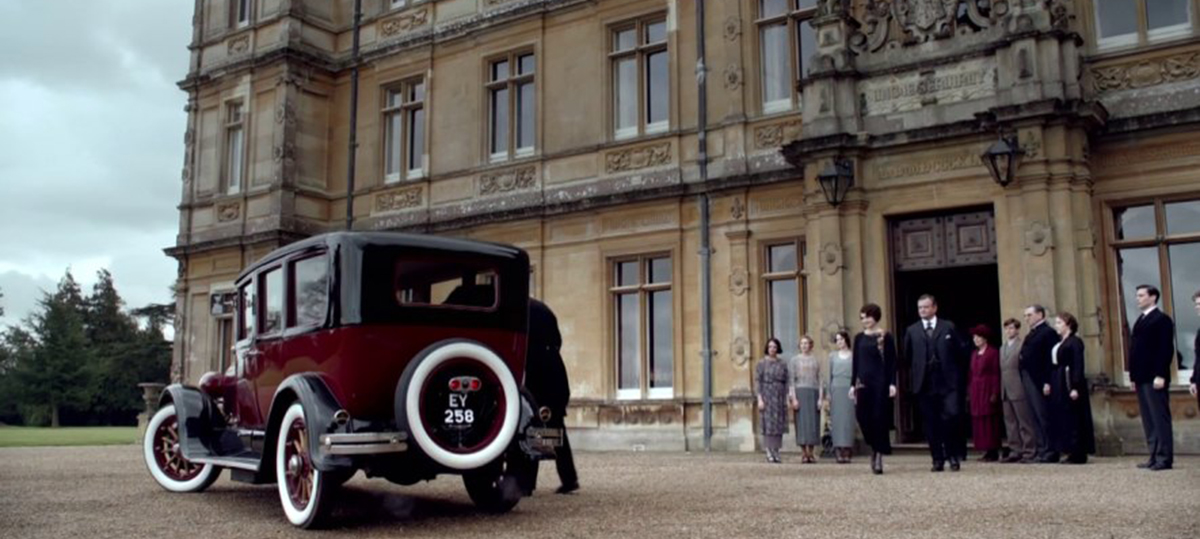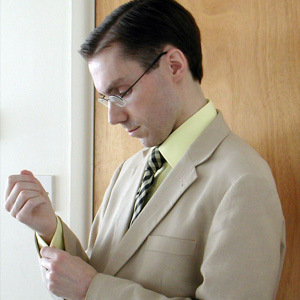The cars of Downton Abbey
When it comes to producing a period drama the vehicles used by the characters, or just those appearing in the background, are every bit as important as the costumes and set. With the overwhelming success of the Edwardian-set juggernaut Downton Abbey, now is a good time to take a look at some of the most prominent cars that have appeared in this splendid series and the history behind them.
Renault
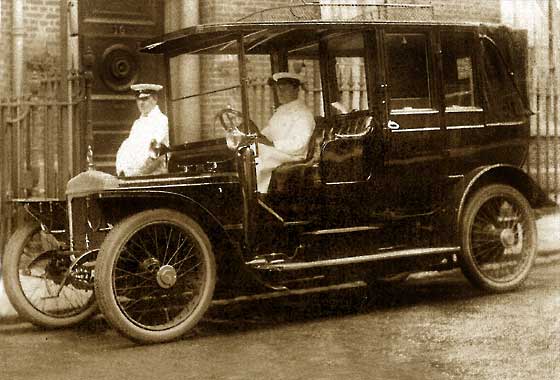
Casting our minds back four years (has it really been that long?!) to the beginning of the first series of Downton Abbey, we recall that it was set in 1912 – just after the sinking of the Titanic, which sets up the basic plot-line for the remainder of the series. Rolls-Royce was barely eight years old but even so had already established itself as the premier manufacturer of luxury British motor cars. However, as we know, Lord Grantham is in dire financial straits and struggling to maintain the Downton estate. A Rolls-Royce is therefore out of the question for the noble Earl, who instead has to make do with a 1911 Renault 12/16 Landaulette. Nowadays we think of Renault as a maker of inoffensive little hatchbacks, but 100 years ago they produced everything from taxis to tractors. Starting out in 1898, by 1912 they’d established themselves as one of the pre-eminent European car manufacturers. The 12/16, introduced in 1909, was one of Renault’s more luxurious offerings and able to be bodied by various independent coachbuilders as was the practice at the time. While the open-top four-seater Torpedo proved popular, Lord Grantham’s model sports a Landaulette body style, a design owing more to the traditional carriages of the 19th century, with a convertible roof covering the passenger compartment (separated from the chauffeur, of course!).
At the beginning of the Edwardian era there were many British car manufacturers producing luxury vehicles and several of these names – many now long forgotten – are represented throughout Downton’s four series. By the time of the second series, which covered the period 1916-20, several more makes of luxury British car were on show.
Rolls-Royce
Rolls-Royce has been a byword for luxury ever since the company was first established in 1904. Its history is well known and would fill many books; suffice to say that with its famous 40/50hp Silver Ghost model staying in production for 20 years it’s not in the least bit surprising to see the marque making the odd appearance at Downton.

The 1913 Rolls-Royce Silver Ghost open tourer of Sir Anthony Strallan, who became Lady Edith Crawley’s on-again-off-again love interest throughout the first three series, is the first Rolls-Royce to make a major appearance. Seen towards the end of the first series in May 1914, Sir Anthony takes Lady Edith “for a spin” in his new Rolls-Royce, setting the scene for their relationship until the events of the third series. With the custom being for Rolls-Royce to provide only the rolling chassis, an independent coachbuilder, such as Thrupp & Maberly, or Park Ward would be left to build the bodywork to the customer’s specifications. The more sporting “tourer” body style favoured by Sir Anthony reflects his status as a wealthy widower who finds the new-fangled motor car an interesting hobby.
As the car of the country’s elite even then, Rolls-Royces continued to make sporadic appearances throughout the remaining run of the show. The other most notable model can be seen during the fourth series in the form of Lord Grantham’s sister, Lady Rosamund’s, Rolls-Royce Phantom I.

The Phantom I was the first in the series of top-level Rolls-Royces and was designed to replace the venerable Silver Ghost. Again the bodywork was constructed separately and so it is impossible to know exactly the age of Lady Rosamund’s Phantom or the name of the coachbuilder. However since the Phantom I was only introduced in 1925 and series four of Downton Abbey is supposedly set in 1922-23, I think we’ve found one of the historical inaccuracies that the show’s critics are so keen to point out!
Napier
D. Napier & Son Ltd, to give the company its full title, was another luxury motor manufacturer during and just after the Edwardian period. Having started out as a printing-press company in the 1830s, Lambeth, father and son David and James Napier had quickly diversified into machines for making munitions, coins and banknotes. The third generation Napier, the splendidly-named Montagu, took the company reins in 1885, on the very cusp of the motoring era. A true engineer like his father, he took great interest in the new technology and was also an ardent cyclist. It was through this hobby that he met the characterful Australian businessman and motoring enthusiast (and equally brilliantly-named) Selwyn Edge. In 1898 Edge had bought an early French car, a Panhard, and showing it to Montagu Napier, expressed his dissatisfaction with some of its characteristics. Napier offered to make some improvements, including to the engine and the steering, and Edge was so impressed with the result that he suggested they go into business together building and selling their own designs. So it was in 1900 that the first Napier motor car appeared.

Napier built up a strong reputation in the following years becoming, among other things, the first to manufacture a six-cylinder engine. By 1913 they were producing 700 cars a year, varying from 18hp to 60hp and, like Renault, supplying taxis to their country’s capital. Edge sold his interest to Napier in 1912, and having agreed to stay out of the industry for seven years, rather bizarrely spent that time farming in Sussex.
During the Great War Napier would turn its attentions to aeroplane engines and military vehicle production. After the war they attempted to restart car manufacturing but struggled in the face of competition from the likes of Rolls-Royce. The last Napier car, the T75, was produced from 1919 to 1924 and after losing out in a bidding war with Rolls-Royce for Bentley in 1931, the company concentrated solely on engines. (It still exists today, I’m delighted to tell you, as Napier Turbochargers.)
In series two and three, set between 1916 and 1921, an older 1908 Napier 45hp Type 23 limousine can occasionally be seen being used by the Bryant family, whose son Major Charles Bryant gets maid Ethel Parks into so much trouble during series two. A wealthy and apparently powerful family, it is little wonder that the Bryants’ car is the same type as was used by the outgoing Prime Minister Herbert Asquith and the Secretary of State for War Lord Derby.
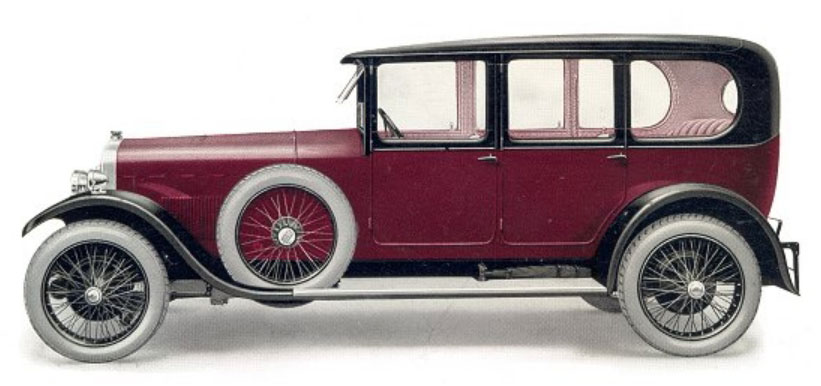
Sunbeam
Sunbeam began, as so many of the early motor manufacturers did, building bicycles during the latter half of the 19th century. They produced their first cars in 1901 but it took until 1905 for the Sunbeam Motorcar Company Ltd to be established. Initially making cars based on a Peugeot design, Sunbeam was creating cars to its own specification, at 650 a year, by 1911. Like Napier it switched to aero engine production during the war and was able to maintain both industries into peacetime. A wide range of products followed, from family saloons to Land Speed Record cars, plus commercial vehicles and buses. As with all luxury manufacturers of the time Sunbeam’s larger limousine models could also be bodied by independent coachbuilders.
By the end of 1920 and the second series, Lord Grantham has managed to replace his ageing Renault with just such a car, a more modern Sunbeam 20/60 Limousine. (In fact a 1924 model – there’s another of those pesky anachronisms!) Sunbeam was a very well-respected, quality manufacturer in its time, on a par with Napier and equivalent to today’s Jaguar (who nearly bought the company in 1935), and this helps to reflect the Crawleys’ slow upturn of fortune, while still maintaining the air of a struggling aristocratic family. The Grantham Sunbeam would go on to be a staple fixture throughout the third and fourth series.
Sunbeam itself would survive until 1978, by which time it was a shadow of its former self, inextricably and confusingly linked with Talbot, Chrysler, and lastly in an ironic twist of fate, Peugeot.
AC Cars
Before it became best-known for its 1960s Cobra, AC Cars, originally Auto Carriers Ltd, had a long history of sporting cars dating back to 1913. The company had started out ten years earlier producing 3-wheeled vans, and then created the “Sociable” passenger version in 1907 before war intervened. Following the cessation of hostilities production of the 1913 four-wheeler restarted, along with a new 6-cylinder engine that amazingly would remain in production until 1963!
In 1921 who should come along but Selwyn Edge, his seven years of “gardening leave”, as agreed with Napier, at an end. Edge joined the board of AC Cars Ltd and oversaw a successful run of motorsport successes, including a win at the 1926 Monte Carlo Rally by works driver Victor Bruce, before taking over the company completely in 1927. The company continues to this day, albeit only producing a modern variation of the Cobra. Its history prior to the 60s seems sadly forgotten today.
It’s very unlikely that anyone cared a fig just what Matthew Crawley was driving at the end of the 2012 Christmas Special (set in September 1921) but just for the record it was a 1927 (okay, so another six years adrift – perhaps those who were pedantic about historical accuracy may have had a point…) AC Six. This car used AC’s long-lived 6-cylinder engine and matches well Matthew’s youthful, forward-thinking personality. Racing success was very much a catalyst for sales in the early years of the motor car and one can imagine Matthew admiring the racy, sporting ACs.
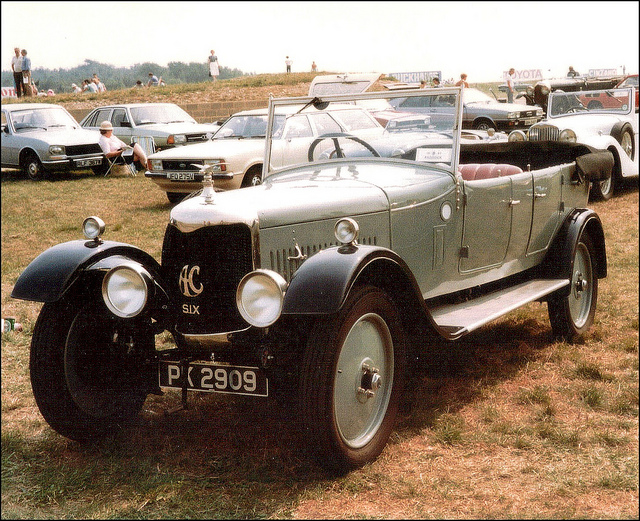
An AC Six was involved in three record-breaking drives in 1927 by The Honourable Mrs Victor Bruce (Mildred Petre). She drove 1,700 miles in 72 hours non-stop from John O’Groats to Monte Carlo, then travelled with her husband and a friend 8,000 miles through six countries to the Montlhéry race track in France where she promptly drove the AC for another 1,000 miles before heading home. Later that year she, along with her husband, an engineer and a journalist, drove through seven countries to within 250 miles of the Arctic Circle – a record that has only recently been bettered. Then in December 1927 she returned to the Montlhéry circuit and set a new 10-day endurance record driving her AC Six over 15,000 miles at an average speed of 68mph. Yet Matthew Crawley stuffs his into a tree after the shortest of journeys. Can you believe it?!
Whether you think Downton Abbey is the best period drama on telly or just a costumed soap opera there’s no denying that the high production values, including the vintage cars peppered throughout the episodes, have gone a long way to making the show such a success. Apart from anything else it gives these old cars a chance to be used just as they were almost 100 years ago and us, the viewer, the opportunity to see these wonderful machines and be reminded of a motoring age and British marques long forgotten.
Downton Abbey will return for its fifth series later this year. Set in 1924-25, it will doubtless feature more cars from the golden era of British motoring for us to enjoy, along with everything else great about the programme.
